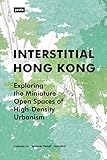Interstitial Hong Kong / Xiaoxuan Lu, Susanne Trumpf, Ivan Valin.
Material type: TextPublisher: Berlin : JOVIS Verlag GmbH, [2021]Copyright date: ©2021Description: 1 online resource (320 p.)Content type:
TextPublisher: Berlin : JOVIS Verlag GmbH, [2021]Copyright date: ©2021Description: 1 online resource (320 p.)Content type: - 9783868596892
- 9783868599596
- 711.4
- HT169.C62 H6645 2021
- online - DeGruyter
- Issued also in print.
| Item type | Current library | Call number | URL | Status | Notes | Barcode | |
|---|---|---|---|---|---|---|---|
 eBook
eBook
|
Biblioteca "Angelicum" Pont. Univ. S.Tommaso d'Aquino Nuvola online | online - DeGruyter (Browse shelf(Opens below)) | Online access | Not for loan (Accesso limitato) | Accesso per gli utenti autorizzati / Access for authorized users | (dgr)9783868599596 |
Frontmatter -- Preface -- Contents -- PART 1: Contexts -- Introduction -- Hong Kong Terra Infirma: A City’s Defiance of Its Slippery Slopes -- Between the In-between: Research Findings on Data-Driven Strategic Urban Design -- On Imported Planning Policies: Adaptability and Resilience of a Small Public Open Space Typology -- Ambiguous Topologies of Public Open Space in Hong Kong: Stairs, Alleyways, Sitting-out Areas, Parks, Playgrounds, Privately Owned Public Spaces and Vacant Lots -- Reassembling the Case Study: Critical Analysis and Design Production in the Studio -- PART 2: Cases -- Index -- Lapse -- Misfit -- Rift -- Littoral -- Gap -- Lacuna -- Authors -- Acknowledgments
restricted access online access with authorization star
http://purl.org/coar/access_right/c_16ec
Enmeshed in Hong Kong’s densely woven urban fabric, wedged between its towering mixed-use complexes and perched along its steep hillsides, sits a network of more than 500 miniature public parks comprising the smallest unit of the city’s public open space network. Though plentiful, these so-called Sitting-out Areas – referred to locally as 三角屎坑 (literally: a “three-cornered shit pit”) – have never been considered in terms of the collective resource they have the potential to be.This book presents a series of critical essays revealing the city’s Sitting-out Areas in relation to Hong Kong’s planning histories and shifting terrains, while also tracking how these spatial fragments have been shaped by concepts of publicness, accessibility and regulation. The second half of the book presents 44 richly illustrated case studies revealing the variety and idiosyncrasies of Hong Kong’s smallest open spaces. Ultimately, the book argues that we can understand the high-density city not only through its buildings, but through the character and potency of its interstitial landscapes.
Im dichten Stadtgefüge Hongkongs, entlang steiler Hänge und eingekeilt zwischen hoch aufragenden Wohn- und Bürohochhäusern, existiert ein Netzwerk von mehr als 500 öffentlichen Miniparks. Diese Kleinsteinheiten des städtischen Freiraums, als Sitting-out Areas oder im lokalen Sprachgebrauch auch als 三角屎坑 („dreieckige Scheißgruben“) bezeichnet, wurden bislang kaum als kollektive Ressource betrachtet.Vor dem Hintergrund von Hongkongs Stadtplanungsgeschichte und dem sich ständig verändernden Grund und Boden setzen sich die Autor*innen kritisch mit den Sitting-out Areas auseinander. Sie erläutern, wie diese räumlichen Fragmente durch Konzepte der Öffentlichkeit, Zugänglichkeit und Regulierung entstanden sind. Daneben illustrieren sie in 44 reich bebilderten Fallstudien die Vielfalt und Eigenarten von Hongkongs Mini-Freiräumen – und zeigen, wie sich hochverdichtete Städte nicht nur über ihre Gebäude erfassen lassen, sondern auch über den Charakter und die Kraft ihrer Zwischenräume.
Issued also in print.
Mode of access: Internet via World Wide Web.
In English.
Description based on online resource; title from PDF title page (publisher's Web site, viewed 01. Dez 2022)


